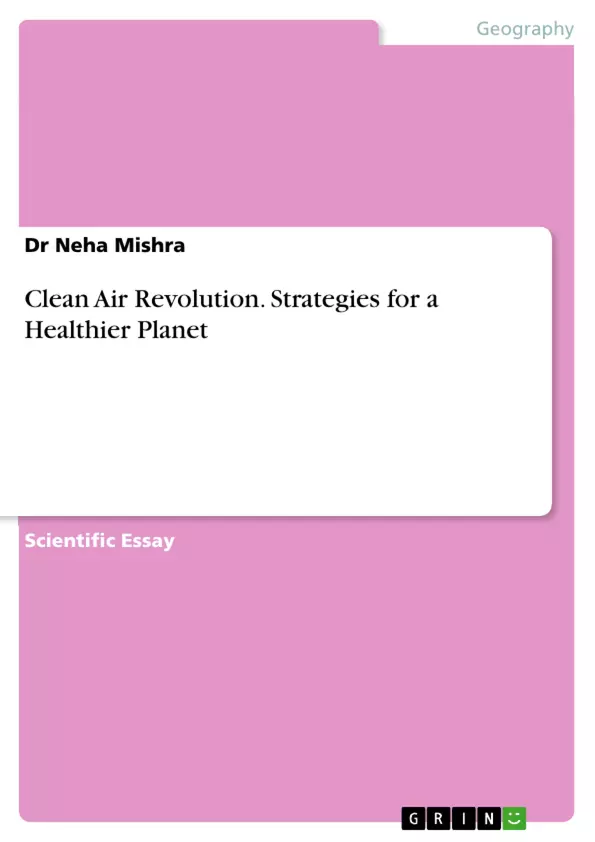Air pollution is a pressing global issue that poses significant risks to human health, the environment, and the overall well-being of societies. It refers to the presence of harmful substances in the Earth's atmosphere, resulting from various human activities and natural processes. This abstract provides an overview of air pollution, including its causes, impacts, and potential solutions.
The sources of air pollution are diverse and include industrial emissions, vehicular exhaust, biomass burning, and the combustion of fossil fuels. These activities release a wide range of pollutants, such as particulate matter, nitrogen oxides, sulfur dioxide, volatile organic compounds, and greenhouse gases. These pollutants have adverse effects on air quality, leading to respiratory and cardiovascular diseases, increased mortality rates, and a range of other health complications.
Air pollution also has profound environmental consequences. It contributes to climate change by amplifying the greenhouse effect, leading to rising global temperatures and altered weather patterns. Additionally, it negatively affects ecosystems, harming plants, animals, and aquatic life through deposition and contamination of pollutants.
Addressing air pollution requires comprehensive strategies and collective efforts. These may include implementing and enforcing stringent emission standards, promoting renewable energy sources, improving public transportation, and fostering sustainable urban planning. Additionally, public awareness, education, and community engagement play crucial roles in advocating for cleaner air and sustainable practices.
Advancements in technology, such as air quality monitoring systems, pollution control devices, and cleaner production processes, offer hope for mitigating the impacts of air pollution. International collaborations and agreements, along with strong governmental policies, are vital for effectively addressing transboundary pollution and promoting global air quality improvement.
In conclusion, air pollution is a complex and multifaceted challenge that demands immediate attention. By understanding its causes, impacts, and potential solutions, we can work towards a cleaner and healthier future for ourselves and future generations.
Inhaltsverzeichnis (Table of Contents)
- Introduction
- Air Pollution
- Sources of Air Pollution
- Classification of Air Pollution
- Air Pollution in INDIA
- Industry plant responsible of air pollution in india
- Effect of Air Pollution
- Effect of Air Pollution on human health
- Effects Of Air Pollution on Animals
- Effects of Air Pollution on Plants
- Economic Effects of Air Pollution
- Air Quality and Emission Standards
- Air Quality Indices
- Air Pollution surveys
- Air Pollution legislation and Regulations
- References
Zielsetzung und Themenschwerpunkte (Objectives and Key Themes)
This book aims to investigate the multifaceted effects of air pollution on ecosystems and human health. It delves into the sources, classification, and impact of air pollution, particularly focusing on the Indian context. The book explores the implications of air pollution on human health, animal life, plant growth, and the economy, examining the complex interactions between environmental degradation and societal well-being.
- Sources and classification of air pollution
- Impact of air pollution on human health
- Effects of air pollution on ecosystems
- Economic implications of air pollution
- Air quality standards and regulations
Zusammenfassung der Kapitel (Chapter Summaries)
The introductory chapter defines pollution and its various types, highlighting the significance of air pollution as a major environmental concern. It discusses the causes, consequences, and global implications of air pollution. The subsequent chapters delve into the sources, classification, and geographical distribution of air pollution, particularly in India. Specific industries responsible for air pollution are identified, and the chapter explores the complex interplay between industrial activity and air quality.
The book then delves into the effects of air pollution on human health, examining the various respiratory and cardiovascular diseases associated with exposure to polluted air. It further explores the impact of air pollution on animals and plants, illustrating the detrimental effects on wildlife and agricultural productivity. The economic consequences of air pollution are also investigated, highlighting the significant financial burden imposed on individuals and economies by pollution-related health issues and environmental damage.
Schlüsselwörter (Keywords)
Air pollution, ecosystems, human health, India, industrial emissions, environmental degradation, health impacts, economic consequences, air quality standards, regulations.
- Quote paper
- Dr Neha Mishra (Author), 2023, Clean Air Revolution. Strategies for a Healthier Planet, Munich, GRIN Verlag, https://www.hausarbeiten.de/document/1364643


